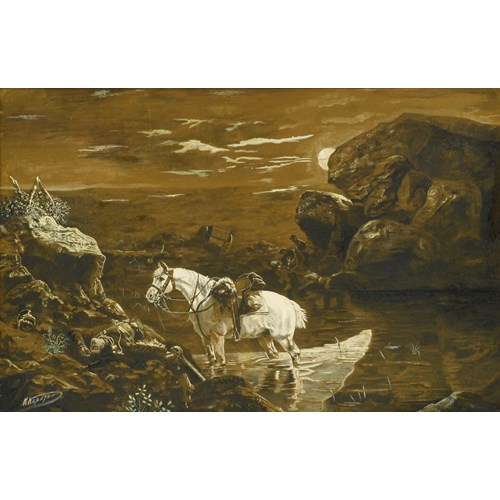Marketplace
Bukharan Jews
Lev Evgrafovich Dmitriev-Kavkazsky
Bukharan Jews
Date 1875
Epoque 1850-1900, 19th century
Origine Russia
Medium Pencil on coloured paper
Dimension 33.7 x 22.5 cm (13¹/₄ x 8⁷/₈ inches)
Reading the subject of Bukharan Jews takes us into an intimate moment, possibly the reading of the Torah, in the life of this couple of exquisitely dressed Bukharan Jews. A beautiful seated lady, her long hair flowing underneath a full-length veil clutches an open book. Her eyes are raised, almost as if in wonder, as she gazes into the unknown distance. Her mouth is slightly open as the viewer observes her reading from the book nestled in her lap. She is wearing a full-length dress, decorated with beads around the collar, and an intricate shawl. Behind her stands a white-bearded man, his right-arm raised for support, as he rests his weight despondently against the wall, whilst his left hangs limp at his side. He wears a prayer hat and a long striped robe gathered at the waist; his loose sleeves are open and rolled back. There is a clear emotional contrast between the two figures: whilst the lady appears ethereal and serene, the man is deep in dejected thought. The scene suggests that the words of the Torah evoke entirely different feelings in each person.
Lev Evgrafovich Dmitriev-Kavkazsky was an engraver on copper, a graphic artist, and etcher. To differentiate him from other artists named Dmitriev he added ‘Kavkazsky’ to his surname, which stemmed from his nickname ‘Caucasian’ and reflected where he was born. In 1869 he attended the Academy of Fine Arts in St Petersburg, where he was taught by the mosaic master F. I. Jordan (1800-1883). The flourishing of mosaic art in the second half of the nineteenth century was closely connected with the construction of St Isaac’s Cathedral, and the plan to replace interior painting with mosaics. Whilst studying at the Academy, Dmitriev-Kavkavsky was awarded two silver medals for etchings of works after Peter Paul Rubens (1577-1640) and Rembrandt van Rijn (1606-1669). The present work, completed in 1875, only a few years after he graduated from the Academy, already shows his exceptional ability as a draughtsman through the beautifully intricate detail and deep tonal differences he achieves with pencil.
From 1883 to 1884 he was editor of the illustrated journal Swallow, which primarily reproduced works by Russian artists, and subsequently for three years he contributed to the journal World Illustration. In 1887 Dmitriev-Kavkazsky was one of the founders of the Society of Russian Illustrators. In 1880, he captured the portrait of the seminal Russian fiction writer, Fyodor Mikhaylovich Dostoyevsky (1821-1881), whose works include Crime and Punishment and The Brothers Karamazov.
In the summer of 1887 he travelled to Central Asia where he completed more than sixty-five engravings. The majority of these works were assembled into the renowned collection of the senator E. E. Reytern, now held in the Russian State Museum. After his travels, Dmitriev-Kavkazsky established a private studio in St. Petersburg and gained a reputation as an artist, collector and academician. In 1903 the young Pavel Filonov (1883-1941) failed his entry examination to the Academy of Arts and entered Dmitriev-Kavkazsky’s private studio where he studied anatomy and life drawing, an experience that enabled him to successfully re-enter the Academy on his second application. At his private studio, Dmitriev-Kavkazsky also taught Mikhail Ivanovich Avilov (1882-1938), Aleksandr Petrovich Apsit (1880-1944), Alexander Vasilievich Kuprin (1880-1960) and the Georgian avant-garde painter David Kakabadze (1889-1952).
Lev Evgrafovich Dmitriev-Kavkazsky was an engraver on copper, a graphic artist, and etcher. To differentiate him from other artists named Dmitriev he added ‘Kavkazsky’ to his surname, which stemmed from his nickname ‘Caucasian’ and reflected where he was born. In 1869 he attended the Academy of Fine Arts in St Petersburg, where he was taught by the mosaic master F. I. Jordan (1800-1883). The flourishing of mosaic art in the second half of the nineteenth century was closely connected with the construction of St Isaac’s Cathedral, and the plan to replace interior painting with mosaics. Whilst studying at the Academy, Dmitriev-Kavkavsky was awarded two silver medals for etchings of works after Peter Paul Rubens (1577-1640) and Rembrandt van Rijn (1606-1669). The present work, completed in 1875, only a few years after he graduated from the Academy, already shows his exceptional ability as a draughtsman through the beautifully intricate detail and deep tonal differences he achieves with pencil.
From 1883 to 1884 he was editor of the illustrated journal Swallow, which primarily reproduced works by Russian artists, and subsequently for three years he contributed to the journal World Illustration. In 1887 Dmitriev-Kavkazsky was one of the founders of the Society of Russian Illustrators. In 1880, he captured the portrait of the seminal Russian fiction writer, Fyodor Mikhaylovich Dostoyevsky (1821-1881), whose works include Crime and Punishment and The Brothers Karamazov.
In the summer of 1887 he travelled to Central Asia where he completed more than sixty-five engravings. The majority of these works were assembled into the renowned collection of the senator E. E. Reytern, now held in the Russian State Museum. After his travels, Dmitriev-Kavkazsky established a private studio in St. Petersburg and gained a reputation as an artist, collector and academician. In 1903 the young Pavel Filonov (1883-1941) failed his entry examination to the Academy of Arts and entered Dmitriev-Kavkazsky’s private studio where he studied anatomy and life drawing, an experience that enabled him to successfully re-enter the Academy on his second application. At his private studio, Dmitriev-Kavkazsky also taught Mikhail Ivanovich Avilov (1882-1938), Aleksandr Petrovich Apsit (1880-1944), Alexander Vasilievich Kuprin (1880-1960) and the Georgian avant-garde painter David Kakabadze (1889-1952).
Date: 1875
Epoque: 1850-1900, 19th century
Origine: Russia
Medium: Pencil on coloured paper
Signature: Signed, inscribed and dated in Cyrillic ‘3 February 1875’ (lower right).
Dimension: 33.7 x 22.5 cm (13¹/₄ x 8⁷/₈ inches)
Plus d'œuvres d'art de la Galerie









